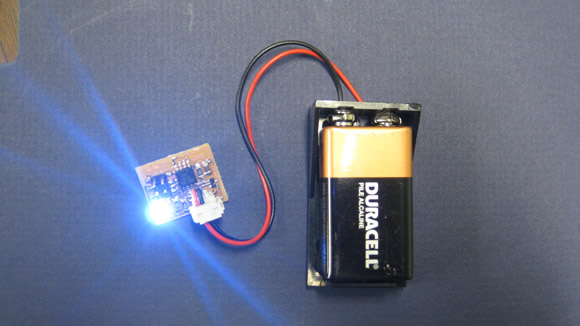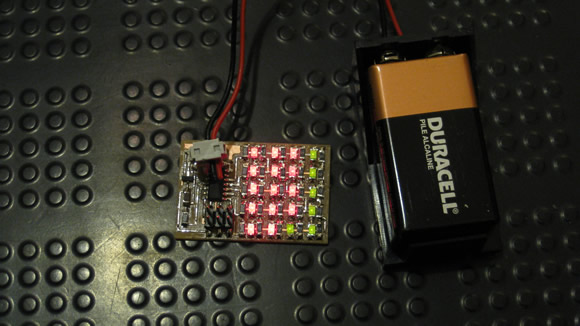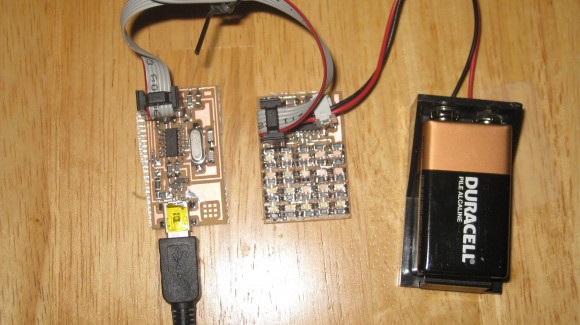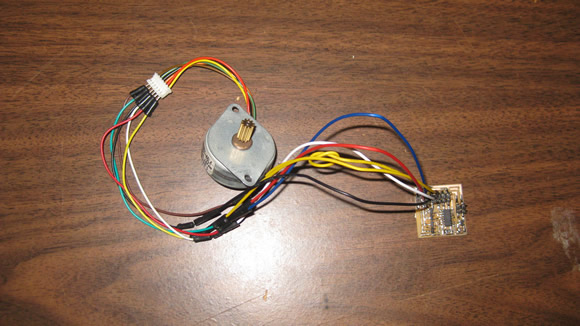Volver al índice de tutoriales
Ejemplos de dispositivos de salida / Conceptos
Índice:
LEDs
Conceptos sobre LEDs
http://learn.adafruit.com/all-about-ledsPlaca Hello RGB

Conceptos sobre RGB LED:
http://www.tumblr.com/tagged/how-do-rgb-leds-workCódigo ejemplo en Arduino:
http://fab.cba.mit.edu/classes/863.12/people/sophia/project11.htmlPlaca Hello LED Array (matrices de LEDs) (Charlieplexing)

Conceptos de Charlieplexing / Matrices de LEDs:
http://www.instructables.com/id/Charlieplexing-LEDs--The-theory/Matrices de LEDs con cortadora de vinilo:
http://www.instructables.com/id/light-circuit/Programando una matriz de LEDs en C (cambiando el código):
http://academy.cba.mit.edu/2012/students/lubsen.astrid/Assignment13.htmlLibrería Charlieplexing para Arduino:
http://playground.arduino.cc/code/charlieplexRGB LEDs usando Charlieplexing en Arduino usando estilo C:
http://academy.cba.mit.edu/2012/students/holt.joshua/JH_week13.html
La placa en funcionamiento
Programando la placa Hello LED Array (matrices de LEDs) con el FabISP

Programando el microcontrolador:
Para programar tu placa Hello LED Array (matrices de LEDs) - descarga todos los archivos situados en el apartado LED array.
Si estás usando un ATtiny44:
sudo make -f hello.array.44.make program-usbtiny
Si funciona - Esto sería lo que aparecería por consola
avr-objcopy -j .text -O ihex hello.array.44.out hello.array.44.c.hex;\
avr-size --mcu=attiny44 --format=avr hello.array.44.out
AVR Memory Usage
----------------
Device: attiny44
Program: 358 bytes (4.4% Full)
(.text + .data + .bootloader)
Data: 1 bytes (0.2% Full)
(.data + .bss + .noinit)
avrdude -p t44 -P usb -c usbtiny -U flash:w:hello.array.44.c.hex
avrdude: AVR device initialized and ready to accept instructions
Reading | ################################################## | 100% 0.01s
avrdude: Device signature = 0x1e930c
avrdude: NOTE: FLASH memory has been specified, an erase cycle will be performed
To disable this feature, specify the -D option.
avrdude: erasing chip
avrdude: reading input file "hello.array.44.c.hex"
avrdude: input file hello.array.44.c.hex auto detected as Intel Hex
avrdude: writing flash (358 bytes):
Writing | ################################################## | 100% 1.08s
avrdude: 358 bytes of flash written
avrdude: verifying flash memory against hello.array.44.c.hex:
avrdude: load data flash data from input file hello.array.44.c.hex:
avrdude: input file hello.array.44.c.hex auto detected as Intel Hex
avrdude: input file hello.array.44.c.hex contains 358 bytes
avrdude: reading on-chip flash data:
Reading | ################################################## | 100% 0.68s
avrdude: verifying ...
avrdude: 358 bytes of flash verified
avrdude: safemode: Fuses OK
avrdude done. Thank you.
Motores
Tipos de motores (Resumen):
- http://www.electronicsteacher.com/robotics/robotics-tutorial/beginners-robotics/motors.php
- http://www.arrickrobotics.com/motors.html
- http://www.instructables.com/id/How-To-Motors/
Conceptos sobre motores DC: H-Bridge / PWM
- http://www.societyofrobots.com/schematics_h-bridgedes.shtml
- http://roko.ca/robotics/h-bridge-fundamentals/2
MOSFETS (para gran carga capacitiva, como motores)
Recursos de las clases de Physical Computing de Paul Badger's:
- http://dm.risd.edu/pbadger/PhysComp/pmwiki/pmwiki.html?n=Devices.Devices
- http://digitalmedia.risd.edu/pbadger/Robo/
Librería Servo de Arduino
Hello Stepper (motor paso a paso)

Si la placa del motor paso a paso no funciona, prueba lo siguiente:
- Los cables pueden estar colocados de forma incorrecta -- prueba a intercambiarlos
- Los pasos son demasiado cortos para el motor -- prueba a alargarlos
- La corriente del paso es muy baja para el motor -- intenta incrementar la corriente PWM
- No funcionan todos los MOSFETs -- revisar con un osciloscopio
